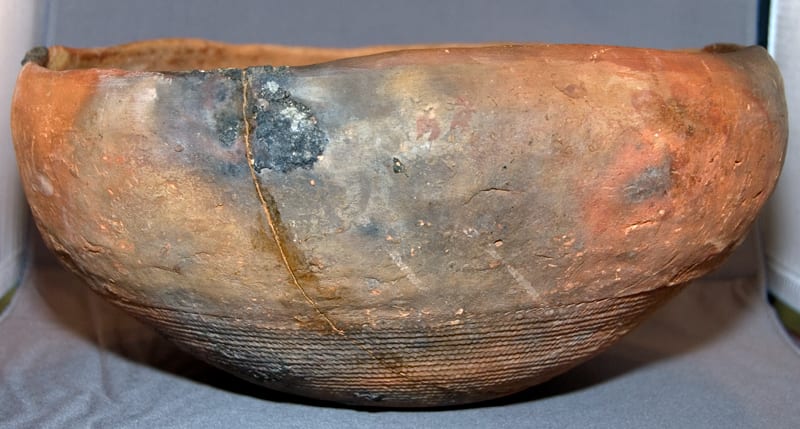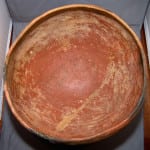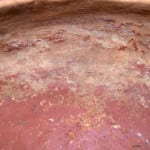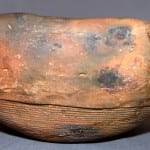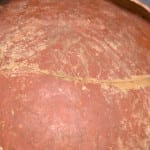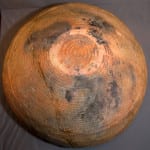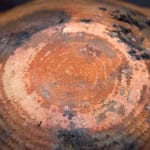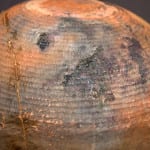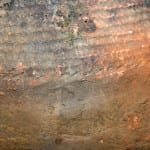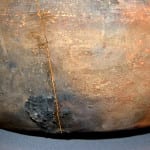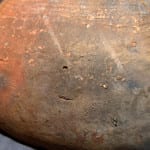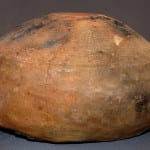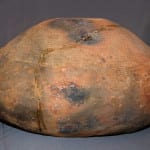The bowl has an outside radius of 10 inches. The bottom 6 inches were formed in a basket; the remaining 4 inches were added with clay coils. The basket had about 30 coils. The edge coil of the basket was finished with a toothed edge forming small triangles whose impressions are preserved in the clay. Perhaps because the basket was not circular, this bowl has an irregular diameter, varying by about a third of an inch. Residue from the firing fuel is fused to the outside of the bowl and its rim. The rim is slightly incurved to facilitate a hand scraping extra batter back into the bowl. The bottom of the exterior has been sanded smooth, presumably when the bowl was moved while being used on a rough floor.
The technique of forming clay bowls in a basket is an ancient one, though rarely practiced today. For a discussion of the relationship between basketry and pottery and the use of baskets to form the base of pottery in the 19th century, see George W. James (1902: 17-20). Figure #11 in James would seem to show exactly how piki bowl 2010-17 was formed (1902:19).
Piki is made on all three mesas, especially for ceremonial occasions, and thus piki bowls are a necessary item in Hopi and Hopi/Tewa homes throughout the reservation. (See 1993-05 for a modern First Mesa piki bowl.) Given the basket-formed technique and the red clay, bowl 2010-17 may be from Oraibi or Hotevilla on Third Mesa.
Bowl 2010-17 is unslipped and made with a clay that fires brick red. In the 1980s, Lydia Wyckoff discovered that the few working potters from Oraibi and Hotevilla generally used red clay (palacoqa) from Third Mesa and occasionally formed bowls in baskets. The clay is actually a pale yellowish gray before firing, and turns a brownish red after firing. Clay from a deposit on Howell Mesa, seventeen miles west of Hotvilla, was also used because it fired a vivid red. Sometimes the Howell Mesa clay was mixed with Third Mesa palacoqa to increase its color (1985:151,153). Bowl 2010-17 has the vivid brick red color of Howell Mesa clay, though there may be other sources for such clay, especially since it was made 60 to 100 years before Wyckoff’s observations. I simply do not know if potters from First and Second Mesa were making piki bowls using red clay during the time when bowl 2010-17 was formed. As far as I know, Second or First Mesa potters did not make basket-formed pots during the 20th century. Based on late 20th century practice, a Third Mesa origin for this older bowl is likely.
The collection contains a huge posole pot (1998-05
) that is old, basket-formed and was made about the same time as piki bowl 2010-17 and four newer pots formed in baskets (1987-02, 2005-01, 2005-08 and 2006-06). All of these pots seem to be from Third Mesa.
Obviously, bowl 2010-17 was broken into four pieces and then glued together, with a few interior chips missing. As with Nampeyo’s piki bowl (2009-17), the interior of bowl 2010-17 has a patina of residue from the corn meal piki batter. It is not clear of the bowl was a) broken, repaired, and continued to be used for making piki, or b) broken and then glued back together at Hopi for sale to the original Anglo collector. Piki batter in some interior cracks would suggest the former; the clean surface of two interior chips would suggest the latter. Or the Anglo collector herself might have glued the four pieces of the broken pot back together.

